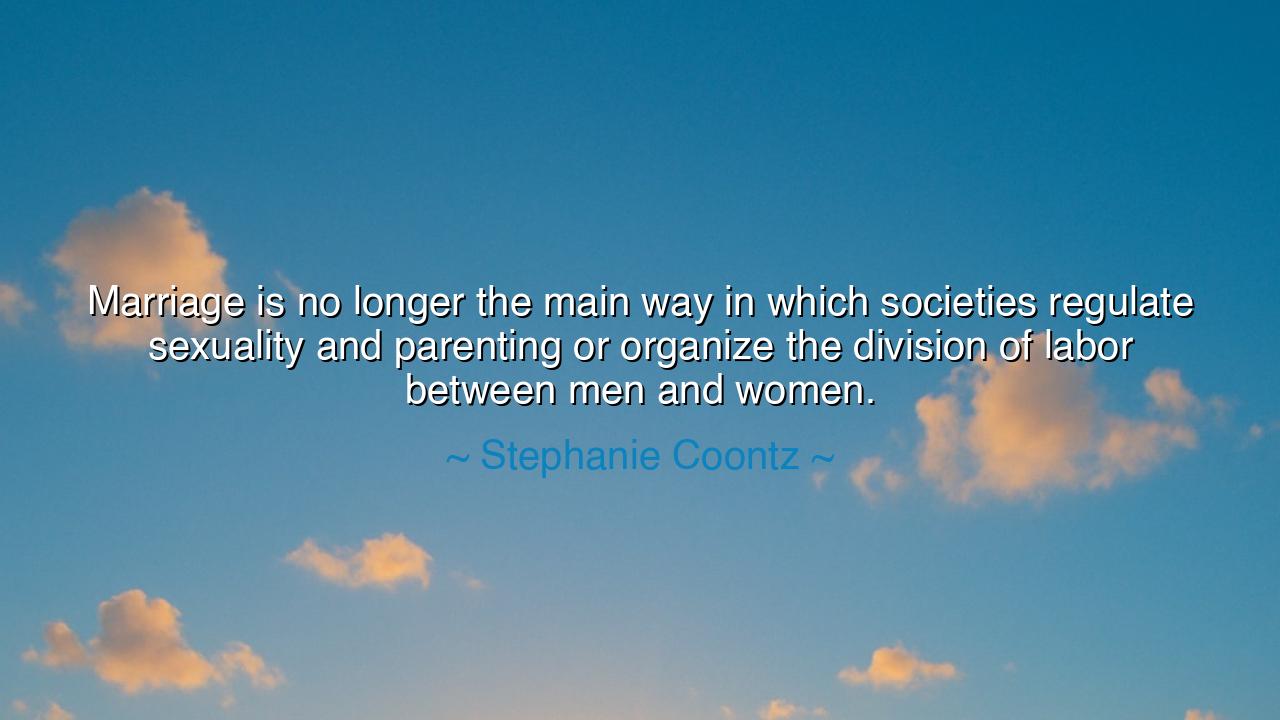
Marriage is no longer the main way in which societies regulate
Marriage is no longer the main way in which societies regulate sexuality and parenting or organize the division of labor between men and women.






Hear, then, the words of Stephanie Coontz, historian of the family and seeker of truth: “Marriage is no longer the main way in which societies regulate sexuality and parenting or organize the division of labor between men and women.” This saying is not a denial of love, nor an attack upon the sacred bond of union, but a recognition of how the river of human life changes its course with the passing of time. What was once the foundation of order has been reshaped by new forces, new freedoms, and new visions of equality. The ancient pillars stand, but their function has shifted, and their weight is no longer the same.
In times long past, marriage was not chiefly about affection or companionship—it was a binding contract. It joined clans, secured alliances, ensured inheritance, and dictated the place of men and women in the household and the community. In these ancient structures, sexuality was governed by duty, parenting was ordered by custom, and the labor of men and women was divided like the earth and sky, with little room for change. Yet the world has moved forward. The chains of necessity have been broken, and men and women alike now fashion new ways to live, to love, and to share the burdens of life.
Consider the tale of Eleanor of Aquitaine, a queen of both France and England. In her marriages we see clearly the old order—her unions were political, forged for power, for the regulation of lineage, for the shaping of empires. Love may have whispered at the edges, but the true voice was that of duty and control. Contrast this with the unions of today, where lovers choose each other not by decree of monarchs or families, but by their own desire. Where once marriage was the gatekeeper of legitimacy, now many raise children outside of its bounds, guided by affection and intention rather than formal bonds. The change is not small; it is monumental, a shift in the very fabric of society.
The division of labor too has been transformed. In the old order, men bore the sword or the plow, while women bore children and kept the hearth. Each task was tied to gender, rigid and immovable. But now, women wield the pen, the tool, the vote, and the voice of authority, while men increasingly join in the nurture of the young and the keeping of the home. The symmetry of labor once forced upon the sexes has been broken, replaced by a new dance, one more fluid, though not without its struggles. Coontz speaks not of chaos, but of liberation—the possibility that men and women may decide for themselves how to share the burdens of life.
Yet let no one think that freedom is without challenge. For when the old order is undone, the path forward must be built anew. Without the strict rules of marriage to regulate sexuality and child-rearing, societies must wrestle with new questions: What does commitment mean? How are children best protected? How do men and women, freed from rigid roles, still honor each other’s contributions without resentment or confusion? The decline of marriage’s power as regulator calls forth not despair, but responsibility, to craft bonds based not on compulsion but on choice and mutual respect.
The lesson for us is this: do not cling blindly to the past, nor cast it aside in arrogance. Marriage may no longer be the sole pillar upon which society rests, but it remains a sacred option, chosen not by force but by will. Let those who wed do so with understanding that they bind not only themselves, but the future they create together. Let those who parent outside of wedlock remember that love and devotion, not formality, are the true cornerstones of a child’s security. And let men and women, in whatever arrangement they choose, divide their labors not by tradition alone, but by fairness, compassion, and respect.
Thus do Coontz’s words carry both warning and hope. For they reveal that society has shifted, but they also remind us that the work of building harmony is never finished. Marriage is no longer the main way—but love, commitment, and shared duty remain eternal. The forms may change, but the essence endures: humanity must ever seek balance between freedom and responsibility, between individuality and community, between desire and duty. And if we walk with wisdom, the new forms will not weaken us, but make us stronger than before.






AAdministratorAdministrator
Welcome, honored guests. Please leave a comment, we will respond soon